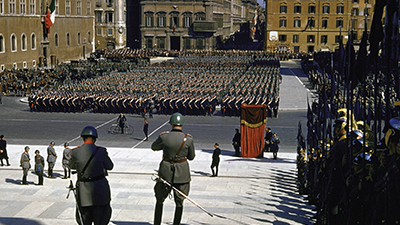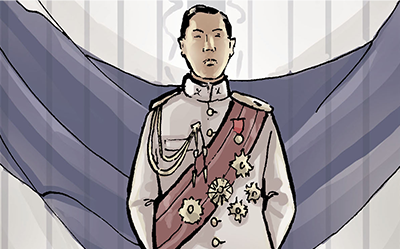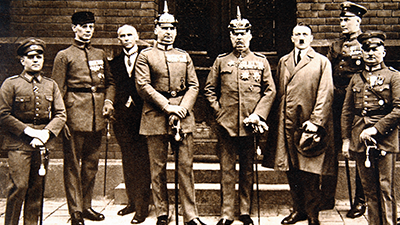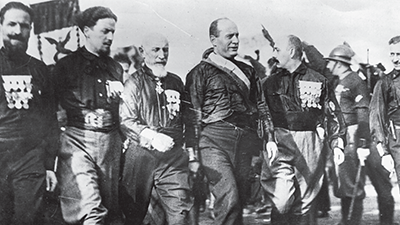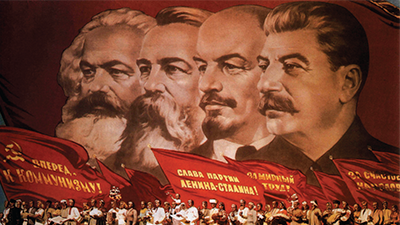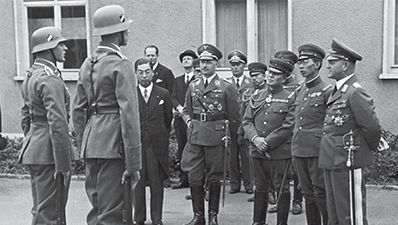Competing Ideologies
Teacher Resources
Driving Question: Why did extremist ideologies like fascism emerge during the interwar period?
In the shadow of World War I, some nations pushed for peace and cooperation while others promised strength through control. Examine the forces that drove these decisions, and the consequences that followed.
Learning Objectives:
- Use evidence to explore how people and nations experienced, remembered, and responded to the costs of World War II.
- Use the historical thinking practices of claim testing and CCOT to evaluate the era of global conflict.
- Create arguments using historical evidence to support claims and communicate conclusions through information and formal writing.
Vocab Terms:
- antisemitism
- authoritarianism
- communism
- concentration camp
- fascism
- internationalism
- party platform
- propaganda
- welfare capitalism
Opener: Competing Ideologies
To teach this lesson step, refer to page 2 of the Lesson 7.6 Teaching Guide.
As you get ready to examine extremist ideologies, step into the shoes of a citizen watching their nation fall to pieces.
A New Threat
To teach this lesson step, refer to page 3 of the Lesson 7.6 Teaching Guide.
Fascism emerged as a powerful force in the interwar period, but it wasn’t the only path forward. Compare how different ideologies, from authoritarianism to internationalism, competed to shape the future in a time of crisis.
-
Guiding Questions
-
Before you watch
Preview the questions below, and then review the transcript.
While you watch
Look for answers to these questions:
- What did the Kellogg-Briand Pact try to achieve?
- What were some efforts at international cooperation in the 1920s?
- How does internationalism in the 1920s compare to earlier attempts in history?
- Why did the League of Nations struggle to succeed?
- What lasting impact, if any, did the Kellogg-Briand Pact have?
After you watch
Respond to this question: How does the failure of internationalism challenge or support the networks frame narrative?
Key Ideas
-
Guiding Questions
-
Before you watch
Preview the questions below, and then review the transcript.
While you watch
Look for answers to these questions:
- What is the origin of the word fascism?
- Why is it useful to define fascism as a political behavior?
- How do fascists gain and maintain power?
- Why did fascists see internationalism as a threat?
- What makes total war important to fascist ideology?
After you watch
Respond to these questions: Which ideas or methods of fascism are similar to systems you’ve seen earlier in the course, such as imperialism or monarchy? How are they different?
Key Ideas
-
Guiding Questions
-
Before you read
Preview the questions below, and then skim the article. Be sure to look at the section headings and any images.
While you read
Look for answers to these questions:
- What actions showed Mussolini’s foreign policy was aggressive?
- How did Germany and Italy justify their expansion?
- How did Japan explain its imperial expansion?
- What did the authoritarian regimes of Italy, Germany, Japan, and the USSR have in common?
- What were some ways the authoritarian regimes of Italy, Germany, Japan, and the USSR were different?
After you read
Respond to this question: Why do you think so many people supported authoritarian or fascist governments, even when those governments used violence and repression?
Closer: Competing Ideologies
To teach this lesson step, refer to page 6 of the Lesson 7.6 Teaching Guide.
Phibunsongkhram’s use of fascist ideas in Thailand was adapted to his local and regional goals. His story expands our understanding of global authoritarianism.
-
Guiding Questions
-
Before you read
Preview the questions below, and then skim the comic, paying attention to things like prominent colors, shapes, and types of text and fonts. How do you know where to start and in which direction to read? What’s in the gutters (the space between panels)? Who or what is the focus of the comic?
While you read
- Why did Plaek Phibunsongkhram rename his country Thailand?
- What is one policy that shows Phibunsongkhram’s authoritarian rule?
- Why did Phibunsongkhram promote pad Thai?
- What happened to Phibunsongkhram after the war?
- How does the design of the biography show that Phibunsongkhram was an authoritarian leader?
After you read
Respond to this question: How does this biography of Phibunsongkhram support or challenge what you’ve learned about authoritarianism and fascism during the interwar period?
Fascism, Communism, and Authoritarianism
To teach this lesson step, refer to page 6 of the Lesson 7.6 Teaching Guide.
Why did so many countries turn to extremist leaders in the interwar years? These articles add valuable global context by examining how fascism, communism, and authoritarianism took root in Italy, the Soviet Union, and Japan. These cases help you compare how different systems responded to crisis—and why so many people supported strong, often repressive, governments.
-
Guiding Questions
-
Before you read
Preview the questions below, and then skim the article. Be sure to look at the section headings and any images.
While you read
Look for answers to these questions:
- How did Hitler exploit the Reichstag fire and how did it benefit him?
- How did Hitler make it look like he was playing by the rules as he consolidated power?
- How did the Nazi government start to take action against German Jews?
- Why were the Nuremberg Laws important in expanding Nazi attacks on German Jews?
- What did the Nazis gain from “othering” and attacking Jewish people?
After you read
Respond to this question: How do you think violence against Germany’s Jews and the consolidation of Nazi power became acceptable or was even embraced by the German public during the 1930s?
-
Guiding Questions
-
Before you read
Preview the questions below, and then skim the article. Be sure to look at the section headings and any images.
While you read
Look for answers to these questions:
- What did it take for the Fascists to defeat the Socialists in Italy?
- What were two ways fascism grew in the Po Valley?
- Why were some fascists disappointed with Mussolini early on?
- What actions did Mussolini take to strengthen his rule?
- How was Italian fascism’s view of race different from Nazi Germany’s?
After you read
Respond to this question: Why do you think Mussolini had less control over Italy than Hitler had over Germany?
-
Guiding Questions
-
Before you read
Preview the questions below, and then skim the article. Be sure to look at the section headings and any images.
While you read
Look for answers to these questions:
- What challenges did Lenin and the Bolsheviks face early on?
- How did the Bolsheviks exercise control over politics and society?
- How did Stalin’s leadership change the way the USSR was governed?
- What effects did the Soviet command economy have on everyday life?
- In what ways was communism under Stalin similar to fascism?
After you read
Respond to this question: In what ways did the government under Stalin affect the role of communities in the USSR?
-
Guiding Questions
-
Before you read
Preview the questions below, and then skim the article. Be sure to look at the section headings and any images.
While you read
Look for answers to these questions:
- How did Japan model its government after Bismarck’s Germany?
- Why was military independence from civilian leadership important for Japan’s expansion?
- What steps did Japan take that made it a fascist or authoritarian state?
- How did Japan’s economy change under government control?
After you read
Respond to this question: What actions could a society take to limit the rise of authoritarian leaders like those seen in Japan during the interwar period?


